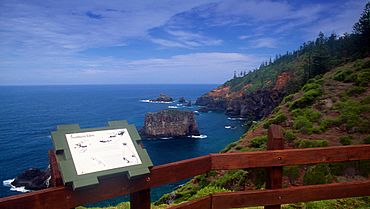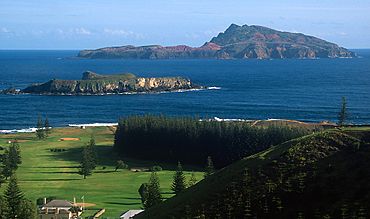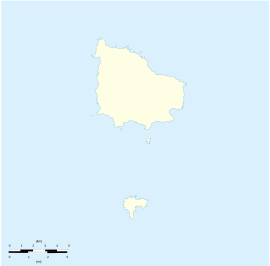Norfolk Island National Park facts for kids
Quick facts for kids Norfolk Island National ParkNorfolk Island |
|
|---|---|
|
IUCN Category II (National Park)
|
|

Captain Cook lookout within the Norfolk Island National Park
|
|

View southward to Phillip Island in the distance. In the foreground is the smaller Nepean Island.
|
|
| Nearest town or city | Burnt Pine |
| Established | 1984 |
| Area | 6.5 km2 (2.5 sq mi) |
| Managing authorities | Director of National Parks |
| Website | Norfolk Island National Park |
Norfolk Island National Park is a special protected area in the South Pacific Ocean. It covers about 6.5 square kilometers (2.5 square miles). This park is located about 1,471 kilometers (914 miles) east of Australia.
The park includes the Mount Pitt area on Norfolk Island itself. It also covers the nearby Phillip Island and the much smaller Nepean Island. Norfolk Island is an Australian territory. It is the only place in the world where you can find the Norfolk Island parakeet and the white-chested white-eye.
The park was created in 1984. The Director of National Parks in Australia manages it. It helps protect many endangered animals and plants. It is also a great place for people who love nature to visit. Park staff keep it running, and the Australian government provides money for it.
Contents
History of the Park
Norfolk Island National Park was officially started in 1984. It is managed by the Australian government. The Mount Pitt area and the Botanical Gardens became part of the park at this time. They were made a National Park under a law from 1975.
Before it was a national park, the land was a public reserve. This meant it was a protected area for everyone to use. Much of the island has steep hills and rocky cliffs. This made it hard to farm, so most of the land stayed wild. During World War II, a radar station was built on Mount Bates. You can still visit it today.
Amazing Plants of the Park
Norfolk Island National Park is home to many unique plants. It has 182 types of native plants. Forty of these plants are found nowhere else in the world. Fifteen of these special plants are in danger of disappearing forever.
For example, the Clematis dubia is a critically endangered plant. It is a woody climbing plant with white, hairy flowers. In 2003, only 15 of these plants were known to exist. The park is very important for its survival.
Plants like this face many dangers. These include losing their homes, fires, and plants from other places taking over. Bad weather and fewer animals that help them grow seeds also cause problems.
Another important tree is the white oak (Lagunaria patersonia). It is a key food source for local animals. These include the Norfolk parakeet and the Lord Howe Island gecko. The Norfolk Island pine (Araucaria heterophylla) is also special. It is found only here and is important to the island's nature and culture.
Animals of the Park
General Wildlife
The park has two native reptiles. These are the Lord Howe Island gecko and the Lord Howe Island skink. Both of these reptiles live only on Phillip Island.
Two types of native bats once lived here. These were Gould’s wattled bat (Chalinolobus gouldii) and the east-coast free-tailed bat (Mormopterus norfolkensis). Sadly, both are now thought to be gone from the island. Many native animals are endangered or have disappeared. This is often because of animals like black rats (Rattus rattus) and wild chickens (Gallus gallus). These animals were brought to the island by people.
Special Birds
Norfolk Island is home to the endangered Norfolk parakeet. These birds are very close to extinction. Wild cats and rats are a big threat to them. These parakeets only live on Norfolk Island.
Park rangers and environmentalists are working hard to save them. They are raising money and moving some birds to safer Phillip Island. Phillip Island has no natural predators for the parakeets. Young parakeets are taken to Phillip Island as chicks. They are hand-fed in a special bird house until they can live on their own.
People helped fund this effort by donating money online. They raised almost $90,000 AUD. This money also helped build homes for the rare Norfolk boobook owl. Extra money was used to plant food for the parakeets. It also helped remove predators from the island.
Sadly, only 7 of the 15 bird species that once lived only on Norfolk Island are still around today.
Park Geography
Climate and Weather
Norfolk Island National Park has a mild climate. This means the weather is not too hot or too cold. In January, the average high temperature is about 21°C (71°F). In July, the average high is about 17°C (62°F).
June is the wettest month, with about 98 mm (3.9 inches) of rain. February is the driest, with only about 37 mm (1.5 inches) of rain. Even in summer, the temperature stays comfortable. There are usually less than one day a year when the temperature goes above 25°C (77°F).
Fun Activities in the Park
Norfolk Island National Park is a popular place for tourists. It offers many activities for people who love nature. The park's Botanical Garden has many rare plants and birds. It is also home to Cyathea brownii, which are the tallest tree ferns on Earth!
Birdwatching is a popular hobby here. There are many hiking trails through the park and around the island. You can also find a golf course nearby. Fishing is another fun activity. However, there are not many native freshwater fish in the park's streams. Only two native freshwater fish have ever been found here. These are the speckled longfin eel (Anguilla Reinhardtii) and the short-finned eel (Anguilla australis). Park staff have added other fish to the streams over time.
The park also has places for barbecues and picnics. You can visit the Captain Cook monument and lookout platform. This spot remembers Captain James Cook, who once called the island a "paradise." The park is also home to Mount Pitt and Mount Bates. These are the two highest points on Norfolk Island.
See also
 In Spanish: Parque nacional Isla Norfolk para niños
In Spanish: Parque nacional Isla Norfolk para niños


